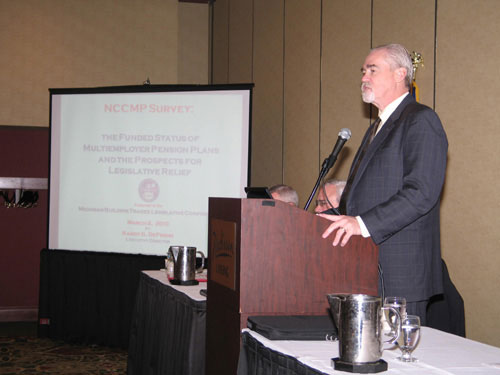Who’s got trouble? We’ve got trouble.
Date Posted: March 19 2010
LANSING – Twice in a six-year period, U.S. stocks and other markets underwent stomach-churning, historic drops that the experts said should only come once in a lifetime.
And to make matters worse, accompanying the second stock market free-fall in the fall of 2008 was the start of the Great Recession for most of the U.S. economy – and what’s shaping up to be a depression for the U.S. construction industry.
Even though stock values have climbed back a bit, the double whammy of sustained lower investment values and plunging construction industry man-hours have wrought havoc on building trades union multi-employer pension plans. Most of the union plans are now in serious financial trouble, with the only way out of insolvency involving instituting changes in federal pension accounting laws, and/or taxpayer bailouts.
That was the gist of a March 2 presentation by Randy DeFrehn, executive director of the National Coordinating Committee for Multi-Employer Plans, to the Michigan Building and Construction Trades Council Legislative Conference. “Multi-employer plans have been hammered,” he said. “The federal government found money to bail out AIG, but they haven’t been willing to put out money for pension plans.”
The federal government sent out surveys to 200 multi-employer fund managers last year to get a handle on their finances. “There was a good response, and it shows how critical the issues are,” DeFrehn said. He said the survey found there are 6.3 million workers among U.S. multi-employer plans, with construction workers representing about one-third of all those participants.
The survey found that going into the financial meltdown in the fall of 2008, multi-employer plans in the U.S. had $266 billion in assets, making the group the largest source of private sector equity in the nation. He said there’s no reason to believe that risky investment strategies led to subsequent losses by the multi-employer funds: 90 percent of the funds are considered conservatively managed.
But the financial meltdown in 2008 was far-reaching. Before the crash in the fall of 2008, 70 percent of multi-employer plans were in the healthy Green Zone, or were more than 80 percent funded. Only 9 percent were in the Red Zone, with funding levels below 60 percent.
By the end of 2009, things changed drastically: only 20 percent of multi-employer funds were in the Green Zone, and 42 percent were in the Red Zone. The Yellow Zone (less than 80 percent funded but with a projected inability to pay benefits within seven years) – had a population of 38 percent.
DeFrehn said the Central States Teamsters pension plan is one that’s really in trouble – and it illustrates the problems for all multi-employer plans and the federal government. In 1980, before trucking was deregulated, the plan had 80 employers. Today, the plan only has two trucking companies barely propping it up – and it has at least $5 billion in unfunded obligations.
But the quasi-government agency that backs multi-employer plans – the Pension Benefit Guaranty Corp. – only has $1.8 billion in total funding ability for all multi-employer plans.
DeFrehn said the federal government seems to have little choice but to change accounting rules that would primarily allow multi-employer plans to restructure, merge, and re-amortize their financial obligations over a longer period of time. In fact, there are two separate bills in the House and Senate that would allow those changes.
The House bill, he said, is better and offers more potential relief for union multi-employer plans than the bill in the Senate. The Senate’s bill would allow for only “limited, targeted relief.” For example – without getting too much into the financial mechanics in the bill – the Senate bill would allow a lesser percentage of recent fund losses to be spread out over a 30-year amortization period. The House bill, among other features, would change accounting rules to allow a much larger percentage of fund losses to be spread out over a longer period of time.
Theoretically, either the House or Senate bill would help pension plans to slow the rate of increased contributions from workers and employers that are currently keeping the plans above water.
“The chances of relief are pretty good, and the Senate’s bill is more likely” to be adopted, DeFrehn said. “But I can’t figure out why there’s any resistance.”
Long-term, of course, the answer to the pension problems is for contributions to pick up resulting from more man-hours worked, as well as improvements in plans’ stock market investments.
But, he said “some plans aren’t going to make it.” For them, fund mergers will be necessary. Federal money will need to be brought in with specific, industry-targeted relief. Right now, the Pension Benefit Guarantee Corporation is not backed by the full faith and credit of the federal government – Defrehn said it should be.
One of the consequences of not doing anything to help the multi-employer plans: the loss of some or all retirement benefits for workers.
“When you figure in investment returns with the 40-60 percent unemployment we have in the building trades, and the roller coaster going on with our investments in the market itself, the snowball becomes an avalanche,” said Michigan Building and Construction Trades President Patrick “Shorty” Gleason to the conference delegates. “It’s imperative that we get a handle on this.”

SOME PENSION PLANS “aren’t going to make it,” said Randy DeFrehn, executive director of the National Coordinating Committee for Multi-Employer Plans, to Michigan Building and Construction Trades Council delegates.
